Liquid Facelift
A liquid facelift is a nonsurgical facelift where a customized combination of dermal fillers and neuromodulators are injected throughout the face for complete facial rejuvenation. Dermal fillers are ideal for improving facial contours, enhancing certain facial features, replenishing volume loss, and reducing deep wrinkles, such as the marionette lines and nasolabial folds. In contrast, neuromodulators like Botox, Xeomin, and Dysport are the gold standard for treating and preventing dynamic wrinkles. The right combination of injectables can result in a natural-looking, long-lasting, more youthful appearance without downtime. A liquid facelift should always be performed by an experienced board-certified dermatologist like Dr. Michele Green to guarantee patient safety and optimal aesthetic results.
As we age, our skin loses collagen and elastin, which leads to the development of fine lines, volume loss, and skin laxity. The accumulation of sun damage and natural aging affects every face differently. This is why the entire face needs to be analyzed in terms of sagging skin, the quality and texture of the skin, and volume loss. There is no single cosmetic procedure that can address all of these factors. Dr. Michele Green will determine the best type of filler for you, depending on the area of the face that needs treatment and the degree of your skin laxity. As an internationally renowned expert in the field of cosmetic dermatology with over 25 years of experience, Dr. Green will combine cosmetic injectables, including Botox, Belotero, Juvederm, Restylane, or Sculptra, with the best non-invasive procedures, such as Thermage FLX and Fraxel, to give you the natural-looking, youthful results you desire.
Dr. Green was one of the first dermatologists in New York to utilize various cosmetic injectables, including Botox, Juvederm, Restylane, Sculptra, and Radiesse, in her private boutique Upper East Side office. Most patients want immediate results without the recovery time from a traditional surgical facelift. A liquid facelift procedure can be performed in under one hour, with lasting results, for up to a year or more, with almost no downtime. When you consult with Dr. Green, she will assess the areas of the face that need to be enhanced and develop a customized treatment plan designed specifically for you. Your plan will include the best skincare, cosmetic injectables, non-invasive skin tightening, chemical peels, and laser treatments.
Dr. Michele Green is an internationally renowned board-certified dermatologist with over two and a half decades of experience providing some of the world’s most discerning individuals with the best non-invasive cosmetic procedures, including the liquid facelift. With over 25 years of experience, Dr. Green takes a holistic approach and embraces a less-is-more philosophy regarding facial rejuvenation, customizing each patient’s treatment plan to suit their specific concerns best and achieve ideal cosmetic results. She is consistently identified as one of New York City’s best dermatologists by Castle Connolly, New York Magazine, and Super Doctors for her dedication to her patients and expertise. When you consult with Dr. Green at her private dermatology office in Manhattan’s Upper East Side neighborhood, she will work with you to create a customized treatment plan for your facial rejuvenation that best suits your needs and personal aesthetic goals.
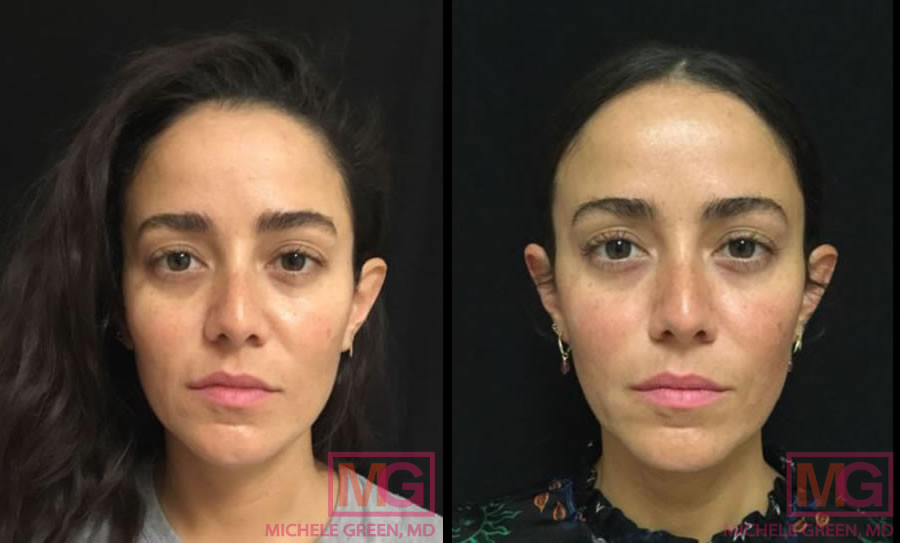
What is a liquid facelift?
A liquid facelift is a nonsurgical facelift that uses a combination of injectables to improve facial contours and target various signs of aging, including fine lines, volume loss, and sagging skin. Neuromodulators like Botox, Xeomin, and Dysport are the gold standard for reducing dynamic fine lines and wrinkles. Dynamic fine lines are formed over time due to repeated facial expressions, commonly affecting the forehead, between the eyebrows (glabella), and outer corners of the eyes (crow’s feet). Neuromodulator injections target the facial muscles related to expression to limit their contraction, resulting in a smoother skin texture. Dermal filler injections, including Juvederm, Restylane, Belotero, and Sculptra, enhance certain facial features and contours, replenish volume loss, and provide a more youthful appearance. Unlike traditional facial cosmetic surgery, a liquid facelift is not associated with any downtime or side effects, making it an excellent treatment option for facial rejuvenation.
Why do patients prefer a liquid facelift to a surgical facelift?
A liquid facelift is a popular cosmetic procedure for facial rejuvenation due to the ease of treatment, lack of downtime, few potential side effects, customizability, and consistently stunning results. As we approach our 30s, 40s, and 50s, collagen and elastin are diminished more quickly than they are produced, and signs of aging like volume loss and sagging skin become more prominent. This results in deep marionette lines and nasolabial folds for some patients. For others, it results in volume loss in the midface or cheek area. Through a combination of dermal fillers, such as Juvederm® Voluma, Volbella, Sculptra®, and Restylane® Contour, Dr. Green will incorporate the best dermal fillers to treat your fine lines and restore volume loss with immediate results. It is no wonder that Botox and dermal fillers are the number one most popular cosmetic procedure in Dr. Green’s private NYC dermatology office.
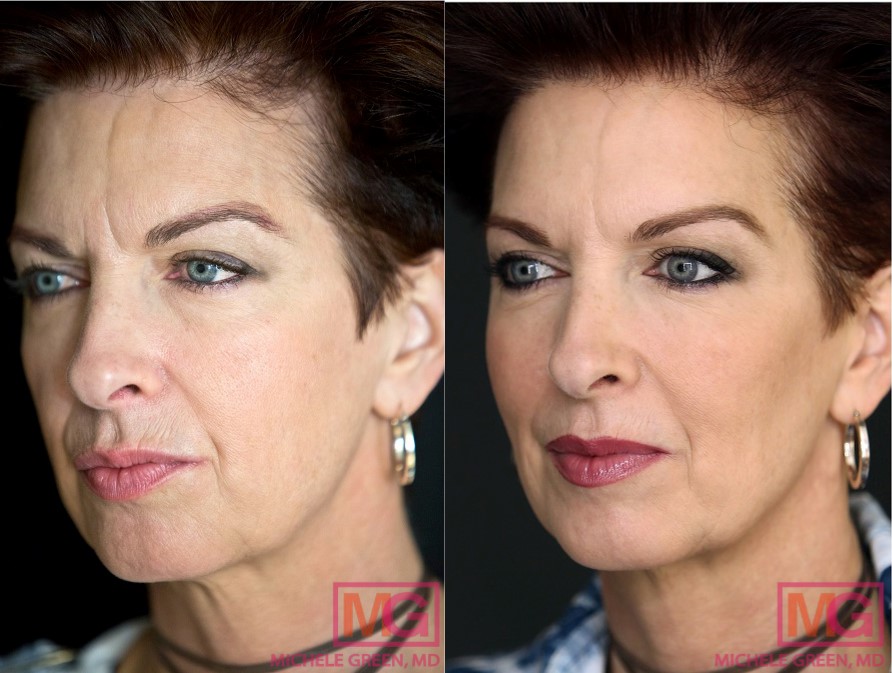
Botox & Voluma before and after
Who is a good candidate for a liquid facelift?
An ideal candidate for a liquid facelift procedure is someone in good health who wants a multi-layered, customized approach to facial rejuvenation and minimal downtime. A liquid facelift can target various signs of aging, including fine lines and volume loss. A liquid facelift procedure can not remove excess skin or treat severely sagging skin. Patients primarily concerned with treating the appearance of sagging skin may benefit from a surgical facelift. A good candidate for a liquid facelift must have realistic expectations regarding the results that can be achieved and understand that the results are temporary and must be maintained regularly. One of the benefits, however, is that a liquid facelift can be adjusted over time as the patient’s needs and preferences evolve. It is important to note that individuals with a history of autoimmune disorders or allergic reactions to cosmetic injectables may not be good candidates for a liquid facelift. Consulting with Dr. Green in her private NYC office is the best way to understand whether or not a liquid facelift procedure is right for you.
Which areas of the face can be treated with a liquid facelift?
- Temple hollows
- Sagging cheeks
- Jowls
- Tear Troughs (under eye area)
- Smile Lines, nasolabial folds, marionette lines
- Chin
- Neck
What is used for a liquid facelift?
A liquid facelift can use various products, including dermal fillers and neuromodulators. Dermal fillers such as Juvederm, Restylane, Sculptra, and Radiesse aim to rejuvenate the face by adding lost volume and restoring collagen. Neuromodulators such as Botox, Xeomin, and Dysport are injections used to reduce fine lines and wrinkles that form from repeated facial expressions. When fillers and neuromodulators are used together, they result in a liquid facelift to improve the various signs of aging. When you consult with Dr. Green in her private dermatology office, she will examine your facial structure and create a customized liquid facelift treatment plan to provide you with a long-lasting, natural-looking, more youthful appearance.
Juvederm Family of Dermal Fillers
Juvederm is a very popular brand of cosmetic dermal fillers used to restore lost facial volume, treat fine lines and deep wrinkles, and improve other visible signs of aging. Juvederm injectable dermal fillers are composed of hyaluronic acid of varying degrees of thickness. The different types of Juvederm injectables are designed to treat various areas of the face, including but not limited to the nasolabial folds, oral commissures, lips, cheeks, chin, jowls, and the under-eye (tear trough) area. Injections of dermal fillers are the basis for a liquid facelift. Juvederm® was first approved in 2006 by the FDA for facial injectable treatment of the nasolabial folds. Dr. Michele Green was one of the first cosmetic dermatologists in NYC to incorporate Juvederm into cosmetic treatments to remove fine lines, deeper lines and hollows in the face.
- Juvederm Vollure – Juvederm Vollure was designed for use around the mouth. Specifically, the filler is used to correct moderate to severe facial wrinkles at the nasolabial fold or marionette lines. With optimal treatment, results are expected to last upwards of 18 months.
- Juvederm Voluma – Juvederm Voluma is one of the most popular dermal fillers. The hyaluronic acid filler is injected into the cheeks and chin to enhance volume and facial structure. It is formulated with a unique Vycross technology, which produces a tightly cross-linked gel and contributes to its “lift” capacity. Voluma was created to redefine the cheek area, which tends to lose structure and volume as we age. Juvederm Voluma is one of the longest-lasting hyaluronic acid dermal fillers on the market today. Patients can expect the filler to last up to two years when injected into the cheeks.
- Juvederm Volux – Juvederm Volux is the newest member of the Juvederm family. The thickest filler of the Juvederm family, Volux, can be injected into the jawline to improve definition and structure. The results often last for one year.
- Juvederm Ultra Plus – Juvederm Ultra Plus has traditionally been used to restore the nasolabial folds, smile lines, and lines around the nose and mouth. It can also be used in other areas of the face, including the chin and jowls. Juvederm Ultra Plus lasts up to one year after injection.
- Juvederm Volbella – Juvederm Volbella® is composed of hyaluronic acid (HA) and is based on Vycross technology. Volbella improves and enhances lip contour, boosts volume, smooths vertical creases, and achieves symmetry in a single treatment. This product treats perioral wrinkles from sun damage and under-eye hollowing. Juvederm Volbella is formulated with an innovative technology, improving HA chains’ cross-linking efficiency. Volbella’s effective cross-linking technology allows for a lower concentration of HA to be used, which results in less swelling. The Vycross technology delivers an ultra-smooth gel, which looks and feels natural for up to one year after injections.
- Juvederm Ultra – Juvederm Ultra was developed to plump the lips and add additional volume. It can also be used around the mouth to restore lost facial volume, smoothing mild to moderate nasolabial folds, smile lines, and marionette lines.
- SkinVive—SkinVive is the most unique of the Juvederm fillers. It is FDA-approved for use on the midface and designed to improve skin smoothness and hydration for the cheeks. Like the other Juvederm fillers, Skinvive is an injectable gel composed of hyaluronic acid. Patients have found their skin smooth and glowing for up to six months after treatment.
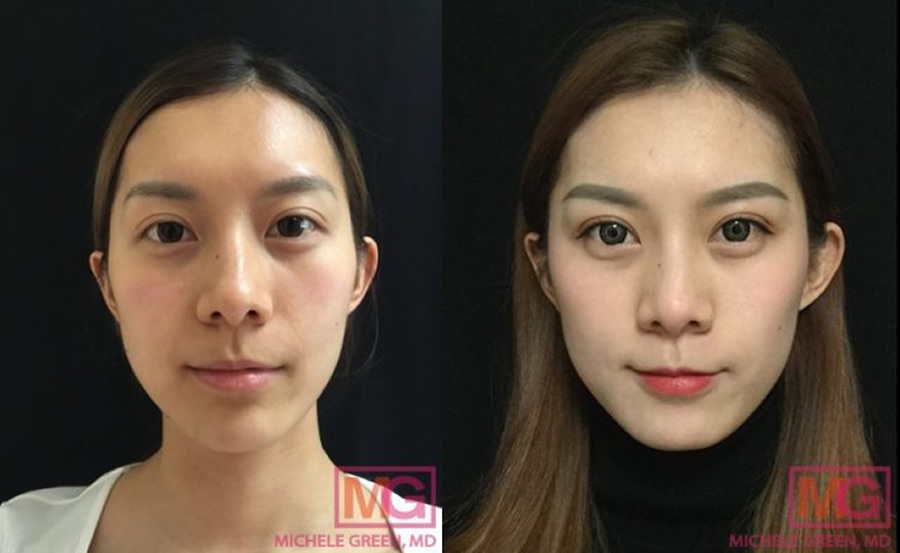
Sculptra – 3 months before and after
Sculptra Aesthetics
Sculptra® is a unique “liquid filler” composed of poly-L-lactic acid (PLLA). The PLLA in Sculptra® stimulates your body’s natural collagen production to help restore facial volume loss and other signs of aging. It can be used in almost any area of the face, including the temples, jowls, nasolabial folds, cheeks, chin, décolletage, arms, and neck area. A series of three or more sessions of Sculptra is indicated to slowly build your own natural collagen, with each session spaced approximately one month apart. After correction with this injectable filler, the results of Sculptra generally last up to two years.
Restylane Dermal Fillers
Restylane® is a brand of dermal fillers composed of hyaluronic acid, which was FDA-approved in 2003 to restore volume and enhance different areas of the face. Hyaluronic acid occurs naturally in the skin, providing volume and essential hydration. This dermal filler can restore volume and collagen to your cheeks, lips, smile lines, under the eye (tear trough), chin, and jowls.
- Restylane and Restylane-L—Restylane and Restylane-L are designed to treat mid-to-deep facial wrinkles and folds, such as smile lines, nasolabial folds, and oral commissures. Restylane-L is a popular dermal filler for tear trough (under-eye filler) and lip enhancement, with natural-looking results. Results are expected to last six to nine months after Restylane injections.
- Restylane Silk – Restylane Silk is designed for lip augmentation and correcting fine lines around the mouth. The low viscosity of the filler makes it uniquely suited to treat the vertical fine lines above the mouth. Restylane Silk lasts for six months after injection.
- Restylane Lyft—Restylane Lyft is used primarily to treat moderate to deep facial wrinkles and folds, to replace lost facial volume in the midface and jowls, and to treat volume loss in the hands. It lasts about one year.
- Restylane Contour—FDA-approved in 2021, Restylane Contour is explicitly designed for cheek augmentation in the mid-face and to replace volume loss in various areas of the face. It is designed with the innovative XpresHAn Technology™, which helps maintain natural expressions and facial movements.
- Restylane Refyne and Restylane Defyne—Restylane Refyne and Restylane Defyne correct mid- to deep facial wrinkles in the nasolabial folds and marionette lines. Restylane Defyne was also FDA-approved for chin augmentation and for treating patients with a receding chin. Both products are designed with XpresHAn Technology, which allows you to maintain the natural expression and movement of the injected area.
- Restylane Kysse—Restylane Kysse is one of the latest injectables for lip enhancement. It has been at the forefront of a popular lip trend, where the filler is injected to create a heart-shaped contour. Restylane Kysse is also designed with XpresHAn technology to allow flexible and natural-looking movement while enhancing your lips’ volume, texture, and color.
- Restylane Eyelight—The newest Restylane product, Restylane Eyelight, was FDA-approved for undereye hollows in June 2023. Restylane Eyelift fills the hollows and decreases shadowing when injected into the tear troughs.
Radiesse Injections for a liquid facelift
Radiesse is an FDA-approved dermal filler comprised of calcium hydroxyapatite. Its unique composition makes it a collagen stimulator, similar to Sculptra. Radiesse is typically used to treat moderate to severe facial wrinkles and folds, such as smile lines and jowls. It is also FDA-approved for skin rejuvenation of the face and hands. The increased collagen stimulation from Radiesse can last up to one year.
Kybella injections and dermal fillers for jawline definition
The most common signs of aging on the neck are submental fat and sagging skin. Submental fat is one of the most common concerns treated in the private dermatology office of Dr. Green. Using a combination of Kybella injections and dermal fillers, Dr. Green can reduce visible signs of aging, eliminate excess submental fat, and provide patients with an elegant and defined jawline. Kybella is a unique injectable that permanently dissolves fat and is most commonly injected under the chin and along the jawline. Dermal fillers can contour and lift the jawline, providing more definition to the chin area. When used with Kybella, this provides a nonsurgical liquid facelift with no downtime.
Kybella is the first and only cosmetic injectable that is FDA-approved to dissolve submental fat and eliminate the double chin, leading to the appearance of a more defined jawline. The active ingredient in Kybella is deoxycholic acid, a naturally occurring substance in the body that aids in the absorption and breakdown of dietary fat. Injections of Kybella permanently destroy fat cells in the treatment area. It takes 4-6 weeks after initial injections of Kybella for the fat cells to be naturally removed and metabolized, ultimately revealing the defined jawline.
After Kybella treatment, dermal filler injections can provide further definition to the jawline, improve the appearance of sagging jowls, and give the face a more contoured appearance. Dr. Green often uses hyaluronic acid fillers such as Restylane Lyft or Juvederm Voluma to create a more defined, contoured jawline for her patients. These fillers provide a lifting effect by supporting the skin in the treatment area and stimulating new collagen production near the injection sites. Jawline fillers are a non-invasive cosmetic treatment with results lasting for up to a year. When you have a consultation with Dr. Green, you can discuss which combination of dermal fillers and Kybella best suits your treatment for a more defined jawline.
Botox Injections with a liquid facelift
Botox® injections are commonly used cosmetically with dermal fillers for overall facial rejuvenation results. Botox, botulinum toxin, is a neurotoxin produced by the bacterium Clostridium botulinum. The neurotoxin is used to treat many medical conditions, from migraines to hyperhidrosis. Cosmetically, Botox is used to minimize facial wrinkles by temporarily freezing the muscles. Botox is often used to treat the dynamic wrinkles of the forehead lines and the lines around the eyes in areas of the face where dermal fillers are “too thick” and cannot be utilized. Dr. Green uses a combination of Botox® and dermal fillers to complement each other in a natural-looking liquid facelift. Botox® is perfect for the wrinkles in the glabella area, forehead, lines around the eyes (crow’s feet), lip lines, lip flips, and the neck’s platysmal bands and folds. Botox can even be used in the DAOs to relax the muscles that pull down the corners of the mouth to create a subtle, happier expression. Botox injections are one of the most popular cosmetic procedures and pair naturally with dermal fillers as part of a liquid facelift.
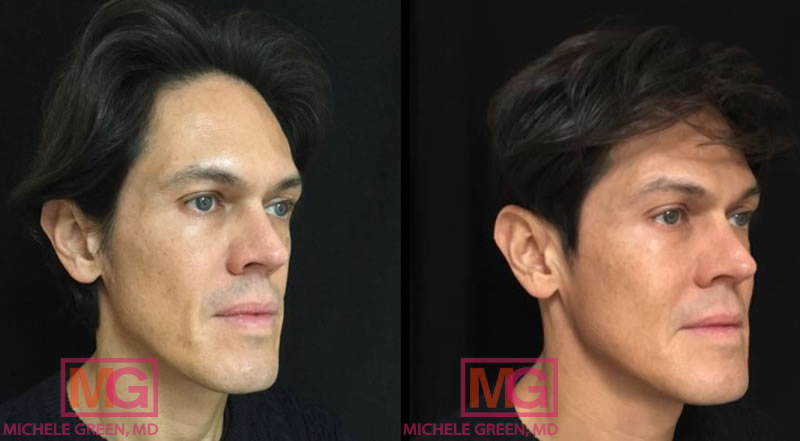
Before & After: Sculptra – 2 treatments
What is the liquid facelift procedure?
The first step is consulting an expert injector, such as board-certified dermatologist Dr. Michele Green. During your initial consultation at her private dermatology office in NYC, photographs will be taken for your private medical record to help you understand your thoughts and track your progress. Dr. Green will collect a thorough medical history, review any previous cosmetic procedures you’ve had, and physically assess the areas of the face that concern you. The key to an excellent result with a liquid facelift procedure is a complete examination of your facial features and areas of volume loss. Dr. Green will determine if you are a good candidate for a liquid facelift or whether you’d benefit more from a traditional facelift surgery. Most patients prefer a liquid facelift procedure over facial plastic surgery, which can involve significantly more potential side effects and recovery time. However, patients with severe skin laxity may require facial plastic surgery to achieve ideal results.
Once Dr. Green determines if you are a good candidate for a liquid facelift, the specific areas and the recommended dermal fillers, such as Juvederm, Restylane, Belotero, or Sculptra, are reviewed. In addition, areas of dynamic wrinkles, such as the glabella, forehead, and crow’s feet, can be treated during your time with a neurotoxin, such as Botox, Xeomin, or Dysport. In addition, Dr. Green may recommend combining other nonsurgical procedures, such as Thermage for non-invasive skin tightening or Fraxel laser for removing sun damage and pigmentation, with an updated skincare regimen to obtain the best cosmetic results.
Once your consultation is complete, a topical anesthetic is applied to the injection areas before your treatment. Dr. Green will then artfully inject the dermal fillers and neurotoxin utilizing a “less is more” philosophy. Dr. Green does not overfill your face with dermal fillers, creating a natural-looking and rejuvenated appearance. Immediately after your treatment, ice packs will be applied to the treated areas, and Arnica Forte is recommended to minimize any bruising from the dermal fillers. Afterward, patients can resume their daily activities, except exercise for 48 hours. Dr. Green recommends a follow-up appointment two weeks after your initial liquid facelift to ascertain if any touch-up is needed.
Can I pair my liquid facelift with other cosmetic procedures?
Yes! Dr. Green often recommends that patients combine their liquid facelifts with other procedures to combat the various signs of aging, including sunspots, texture discoloration, and sagging skin. While there are many non-invasive cosmetic procedures, Dr. Green often uses laser treatments like the Fraxel and Thermage lasers in conjunction with liquid facelifts to target all the signs of aging.
The Fraxel Dual laser is a non-ablative, FDA-approved skin resurfacing facial treatment that utilizes fractional laser technology. The laser operates on two distinct wavelengths, 1927 and 1550 nm, to stimulate collagen production in various dermis layers. The two wavelengths treat different skin conditions, with 1927 best used for hyperpigmentation and sun damage and 1550 for fine lines and improving skin texture. The two wavelengths can be used together for overall facial rejuvenation, improving discoloration, and eliminating textured skin for a brighter, youthful appearance. Since the Fraxel laser is non-ablative, it can treat and change the deeper layers of the skin while leaving the surface undamaged- meaning there’s minimal downtime involved. Patients often experience mild redness, peeling, or swelling for a few days after treatment. The cosmetic effects of Fraxel usually start to become observable within a few weeks; however, most patients with severe sun damage require an average of three treatment sessions spaced four weeks apart for the best cosmetic results.
Thermage is a radiofrequency skin tightening treatment with many benefits but primarily creates firm, smooth, youthful-looking skin without requiring surgical procedures or downtime. The treatment is safe for many body parts, including the face, neck, abdomen, arms, legs, and buttocks. Thermage relies on radiofrequency technology to heat the dermis, which stimulates collagen production, tightening and smoothing the skin. In addition to skin tightening, Thermage treatment will also help to improve the skin’s overall texture, reducing the signs of aging such as crepey or loose skin as well as fine lines and wrinkles. Thermage treatment is an excellent cosmetic procedure for overall rejuvenation. After treatment, results will be evident four to six months after treatment and last up to two to three years. Many patients opt for annual maintenance treatments for the best cosmetic results.
What are the side effects of a liquid facelift?
A liquid facelift has few side effects compared to a surgical facelift. The primary side effects experienced by patients are localized swelling and bruising around the injection sites. To minimize bruising and swelling, we advise patients to refrain from aspirin, Advil, Motrin, vitamins, herbal supplements, fish oil, or any blood thinners for the week leading up to their liquid facelift and the week after treatment. These medications can cause bleeding and excessive bruising at the injection sites. Additionally, we recommend patients take Arnica Forte to minimize bruising.
What is the downtime for a liquid facelift?
After receiving a liquid facelift, patients can resume most daily activities. Swelling and bruising can result from any facial injection lasting several days to a week. However, after receiving dermal fillers, patients should refrain from touching the injection sites for at least 24 hours, avoid strenuous exercise for 48 hours, abstain from alcohol consumption for several days, and discontinue blood-thinning medications or supplements for several days. These activities can worsen swelling and bruising.
Are liquid facelifts safe?
Yes! Liquid facelifts are a safe, non-invasive cosmetic procedure when performed by a board-certified dermatologist or expert injector like Dr. Michele Green. When an experienced dermatologist or plastic surgeon injects dermal fillers, you can be assured of fewer side effects or adverse outcomes. A thorough anatomical understanding of the face is essential, as severe adverse side effects can occur otherwise. Dr. Green is a board-certified dermatologist with over 25 years of experience providing her patients with the best nonsurgical cosmetic procedures for beautiful, natural-looking, long-lasting facial rejuvenation results. When you work with an expert injector like Dr. Green, you guarantee that your dermal filler treatment is centered around patient safety and satisfaction.
Does a liquid facelift hurt?
A liquid facelift causes minimal pain and discomfort. A topical numbing cream can be applied to the injection sites one hour before treatment to minimize discomfort. Additionally, the dermal fillers are compounded with lidocaine, an anesthetic that makes the procedure more comfortable for the patient. Most patients find that their liquid facelift procedure is associated with little discomfort or downtime.
How long does a liquid facelift last?
A liquid facelift lasts approximately six months to two years, depending on the amount and type of dermal filler used in the various areas of the face. Restylane typically lasts between 6 and 9 months after injection. Juvederm fillers last between 6 months and two years, depending on the number and type of syringes injected into the treated area. Sculptra is known to last the longest of any cosmetic injectable filler, with results lasting two years. Typically, a touch-up is scheduled six months to a year after a liquid facelift, depending on the desired cosmetic results, the product’s longevity, and the amount of dermal filler injected into the area.
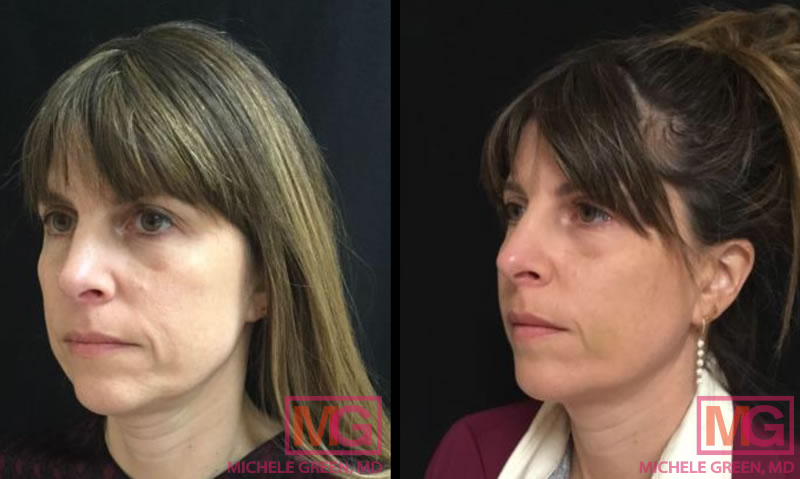
Before & After, Voluma & Lyft
How much is a liquid facelift?
The price for a liquid facelift varies depending on the amount of dermal filler used, the number of syringes used, and the expertise of the cosmetic injector. A liquid facelift with a board-certified cosmetic dermatologist will be more expensive than a nurse injector at a medspa. However, having your treatment with an expert injector is worth it to guarantee that you get the best cosmetic results and avoid encountering unwanted side effects. Since liquid facelifts are personalized treatments, the exact number of syringes of dermal filler needed will depend upon the areas of the face being treated, the desired results, and the type and severity of the signs of aging present. The best way to understand the type and amount of dermal filler needed for your liquid facelift is by consulting an expert injector, such as board-certified dermatologist Dr. Green.
When you consult with Dr. Green at her private dermatology office in the Upper East Side neighborhood of Manhattan, you can discuss your specific skin concerns and overall aesthetic goals with her. Dr. Green will assess your facial features and discuss which facial areas would benefit the most from the immediate results of dermal fillers and new collagen production. Dr. Green will then work with you to develop a personalized treatment plan for your liquid facelift procedure, and the approximate number of syringes of dermal filler needed will be determined.
What is an S-lift facelift?
The S-lift facelift, a type of mini surgical facelift, offers several benefits that can improve the appearance of various signs of aging in the lower face and neck. The name ‘S-lift’ comes from the shape of the incision made during the procedure, which is an ‘S’ shaped incision at the hairline and ear, concealing the scar. This procedure is particularly effective for targeting moderate to severely sagging skin in the lower face. Compared to a traditional facelift, the S-lift is less invasive, requires less downtime, and treats a smaller area.
What is a 5-point facelift?
A 5-point facelift is a nonsurgical cosmetic procedure that entails injecting dermal fillers into five specific sites on the face, primarily where aging and laxity are most apparent. The fillers are injected into the cheeks, temples, tear troughs, jawline, and nasolabial fold/marionette lines. These cosmetic injections rejuvenate the face by stimulating new collagen production in the skin and supplying essential hydration and volume necessary for a more youthful appearance.
What is the 8-point facelift?
The 8-point facelift is synonymous with a liquid facelift. This cosmetic procedure is designed to lift and rejuvenate the appearance by targeting eight strategic points on the face. By combining Botox and dermal fillers, the structure of the face is lifted, including the lower and midface, cheekbones, and areas of volume loss are enhanced, including the midface, nasolabial folds, jowls, and jawline.
Which facelift lasts the longest?
The results from a surgical facelift will last the longest, with results expected to last around ten years. Regarding the liquid facelift, the longevity is based on several factors, including the type and amount of injectables used. When Botox or another neurotoxin is used as part of a liquid facelift, the results from the neurotoxin are expected to last three to four months. On the other hand, dermal fillers used during a liquid facelift can last six months to two years. Because of the variable longevity, many patients receive maintenance touch-ups every six months after a liquid facelift to maintain the best cosmetic results.
Which type of facelift is best?
No facelift is inherently better than another since they are best used to address different concerns. A surgical facelift is indicated when a patient has severe skin laxity that cannot be corrected with dermal fillers and other non-invasive cosmetic procedures. When a patient would benefit from a surgical facelift, they should consult with an experienced board-certified plastic surgeon who can advise patients on the best surgical facelifts for their aesthetic goals and needs. When patients want a non-invasive treatment option for the various signs of aging, including mild to moderate sagging skin, volume loss, and various wrinkles, a liquid facelift may be the option for them. A liquid facelift is customizable and can target the specific areas of concern for each patient, resulting in more youthful, smooth skin across the entire face. When you consult with Dr. Michele Green in her private dermatology office in NYC, she can determine if you are a better candidate for a liquid or surgical facelift.
What age should I get a facelift?
There is no “best” age to receive a facelift, liquid or surgical. Most people associate having a facelift with older age, reserving that treatment option for their 50s, 60s, or 70s. Rather than focus on the best age for having a facelift, patients should be attentive to the signs of aging that would make them a good candidate for the procedure. Suppose you are bothered by skin laxity, loose jowls, deep nasolabial folds, and a hollow-looking midface and would not benefit from having a nonsurgical cosmetic treatment. In that case, you may be a good candidate for a facelift, regardless of your age. Some benefits of having a facelift at a younger age include a faster recovery time and natural-looking, subtle rejuvenation rather than a dramatic change. Consulting with a board-certified plastic surgeon or dermatologist, like Dr. Green in NYC, is the best way to learn whether or not you are a good candidate for a facelift.
A liquid facelift is the ideal cosmetic procedure for a busy man or woman who cannot afford the downtime and side effects of a traditional plastic surgery procedure. Patients between their 30s and 70s can maximize the benefits of a liquid facelift and achieve a natural-looking, long-lasting, more youthful appearance. Regardless of a patient’s age, the goal of having a liquid facelift is to diminish various signs of aging, replace lost facial volume, and enhance the contour and definition of key facial features without the need for an invasive surgical procedure or lengthy downtime. On the other hand, patients in their 50s and 60s most commonly opt for a surgical facelift when nonsurgical treatments such as Thermage skin tightening or a liquid facelift cannot yield the desired facial rejuvenation. Suppose you are still determining whether a liquid or surgical facelift would be more appropriate for addressing your concerns and achieving your ideal results. In that case, the best first step is having a cosmetic consultation with an expert in the field, such as board-certified cosmetic dermatologist Dr. Michele Green.
When should you choose a surgical facelift instead of a liquid facelift?
A surgical facelift is recommended over a liquid facelift when there is an excess of skin laxity that dermal fillers cannot improve. In these cases, a surgical facelift is needed to “pull” the skin and remove excess skin. A mild to moderate amount of skin laxity may be successfully treated using dermal fillers and skin-tightening lasers such as Thermage. Patients with a significant amount of skin laxity would benefit more from having a surgical facelift. Dr. Green can help you determine whether you are a better candidate for a liquid or surgical facelift when you consult with her at her private dermatology office in Manhattan’s Upper East Side neighborhood.
How to avoid plastic surgery
The key to avoiding plastic surgery is first avoiding the damaging effects of the sun and adequately protecting yourself from UV (ultraviolet) light. Exposure to excessive UV light can cause an increase in damage to the skin, thinning the skin, accelerating collagen and elastin loss, and causing an increase in age spots, sun spots, deep wrinkles, and fine lines. Using the proper sunscreen with an SPF of 50 or higher, combined with the best skin care products, will help protect and treat sun-damaged skin. Daily sunblock combined with Retinol creams and antioxidant serums, such as Vitamin C serum, can help reverse sun damage and lighten brown and red spots. Dr. Green’s MGSKINLABS products are made with the best anti-aging ingredients and will help restore sun-damaged skin.
The proper in-office cosmetic procedures, like laser treatments or dermal fillers, can augment sun avoidance and good skincare to help you avoid plastic surgery. Yearly Fraxel laser treatments to remove sun damage and annual Thermage treatments for non-invasive skin tightening help produce new collagen and restore healthier, younger-looking skin. In addition, Botox injections have been shown to have preventative effects, as they can stop deep frown, forehead, and Crow’s feet lines (around the eyes) from forming or becoming deeper. Similarly, dermal filler injections replenish lost collagen and can have a positive long-term preventative effect.
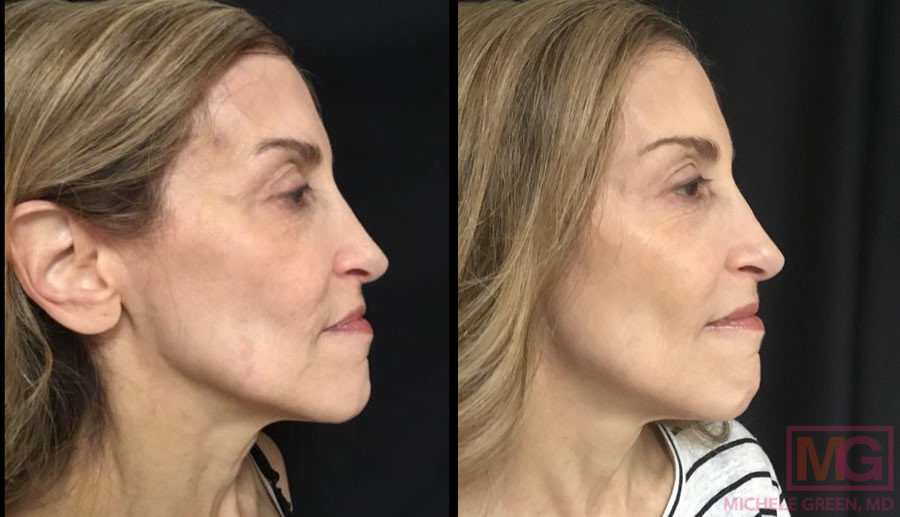
Are liquid facelifts worth it?
For many patients, a liquid facelift is worth the cost because the alternative of a surgical facelift has too many drawbacks. A liquid facelift is the ideal cosmetic procedure for patients interested in achieving facial rejuvenation and reversing the signs of aging without requiring an invasive plastic surgery procedure and lengthy downtime. When a patient is concerned with signs of aging, such as facial volume loss and the appearance of wrinkles and fine lines, and does not have severely sagging skin, it is always worth consulting an experienced, board-certified dermatologist like Dr. Green to see if a liquid facelift is right for you. A liquid facelift is safer and less expensive than a traditional surgical facelift, and patients enjoy the fact that the cosmetic results from their treatment are observable quickly and without much downtime involved.
When you have your liquid facelift procedure with a board-certified dermatologist, such as expert injector Dr. Michele Green in NYC, it is possible to achieve pan-facial rejuvenation results that are natural-looking and long-lasting. Having your liquid facelift with an experienced and knowledgeable board-certified dermatologist is always recommended to guarantee that you achieve optimal results and avoid any potential unwanted side effects. Dr. Green has over 25 years of experience providing her patients worldwide with the best non-invasive cosmetic procedures, including liquid facelifts. Dr. Green will work with you to create a completely personalized liquid facelift treatment plan best suited to your unique needs and aesthetic goals.
How to get started with a liquid facelift
Liquid facelifts are incredibly popular with patients seeking facial rejuvenation because of the minimal downtime and consistently stunning results. A liquid facelift can improve facial contours and target various signs of aging, including fine lines, volume loss, and lack of facial contour. Improving skin elasticity, reducing the appearance of wrinkles and fine lines, and diminishing other signs of aging have never been easier, thanks to the accessibility of a liquid facelift procedure. In a thirty-minute visit, Dr. Green can stimulate collagen production, restore facial volume loss, and provide a more youthful appearance.
Dr. Michele Green is an internationally renowned board-certified dermatologist with over 25 years of experience providing the world’s most discerning men and women with the best non-invasive cosmetic procedures, including the liquid facelift. She is consistently identified as one of New York’s best dermatologists by New York Magazine, Super Doctors, and Castle Connolly for her dedication to her patients and expertise. When you consult Dr. Green at her private dermatology office in Manhattan’s Upper East Side neighborhood, she will physically assess your skin condition and review your particular concerns to develop a customized treatment plan for your nonsurgical facelift that provides you with a natural-looking, long-lasting, more youthful appearance. If you would like to learn more about liquid facelifts, you can schedule a consultation with Dr. Green by calling the NYC office at 212 535 3088 or contacting us online.
 212-535-3088
212-535-3088